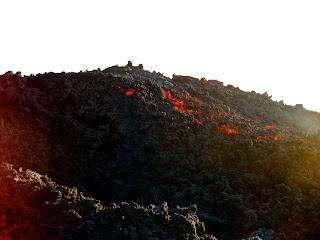





My shoes were burning, I could feel the heat underneath as the smell got stronger. There was a thick mass of people making their way up behind me, there was nowhere to go but up and fast. Ouch! I yanked my hand back from the rock, full of searing heat whenI had tried to boost myself up by grabbing a hold. Getting up was much harder now, still as steep as ever, but now burning hot as well. I scrambled 10 meters up, and stopped dead in my tracks not caring if my shoes melted off my feet—molten hot lava less than 7 meters from me. So close a tall European boy was standing with his face turned against the heat, his hand outstretched in the opposite direction roasting a marshmallow. Roasting a marshmallow from the heat of molten hot lava, cooool. Plane to Guatemala $330, expensive hiking gear $200+, hiking 2 hours up steep, precipitous volcano slopes $9.99, a bag of Guatemalan marshmallows $3.00, stick that will later be given back to the children who sold it to you $0.61 cents, seeing molten hot lava a few feet away: priceless.
Molten hot lava is awesome, words nor pictures can do it justice, and I think that’s because it’s not something you just see, it’s something you feel. Literally it’s hot! The lava slowly creeping down the side of Volcán Pacaya was a rich nutrient black volcanic rock shiny from the extreme heat and pressure of melting criss-crossed and terraced with the burning ember and orange glow that is not a color so much as a property of heat. Another reason, I think it’s so awesome to see lava, is because let’s face, when do you ever see lava unless you stupidly hike-up an active volcano looking for it (best case scenario) or a volcanic eruption occurs (worst case scenario). And it was stupid, there we were dozens of people, gawking at real, live molten lava, roasting marshmallows and posing for pictures while suffering intense heat and the consequential strong smell of burning rubber.
If the way going up was hard, the way coming down was just plain dangerous. There were too many people and the footing was loose volcanic rock on a steep slope, never a good combination. At points I could have been surfing down the mountain, I had so little control of the rocks underneath. Going down by yourself was dangerous, but I was more scared of the people behind me. A boulder was knocked down, and we all scrambled to get out of its way. The guy in front of me clamped it between his legs to stop it from hitting a frightened and paralyzed women in front of him. He suffered a serious gash, but it could have been much worse. And it was starting to get dark. Carlos was a great guide though, he hustled us together and got us moving through the worst parts before there was no natural light left. The worst was over, we still had to hike an hour and a half in the dark but it was mostly declining trails. Behind me the lava, brighter in the dark was picking up speed and giving a magnificent display. Dozens of people were attempting to capture it and you would see the constant pop of camera flashes going off. How they were getting down in the dark beats me, but I didn’t envy their trip one bit.
Finally at the bottom ourselves after a mainly uneventful hike down, we reached the kids begging for the sticks and flashlights back so they could re-sell them to a swarm of tourists the next day. There was a festive air, but it could just be because we were all thrilled and happy we survived. It was probably one of the more touristy, crowded things we had done thus far. There were certainly no Guatemaltecos besides the guides and taxis. Yet to me it resounded as one of the most authentic experiences I’ve had. Nowhere else are volcanoes such a prominent feature of the landscape and integrated into the dynamics of the land from soil properties to abundant hot springs. Nowhere else would offer such an adventure either, not for nine bucks, and definitely not without a slew of waivers and requirements to sign off. But here was a country that settled a village at the base of a volcano. Carlos, the other guides, and townspeople including children grew up traversing the volcano and exploring their land with or without tourists. As Carlos explained to me, “ I love my job, I get to go out and climb a mountain everyday, breathe fresh air, stay close to my home, meet people from all over. The people that leave to go out to the big cities are unhappy, the do work they do not enjoy, and travel far from their homes and families for what? I am happy to stay here, and I am glad people want to see all parts of Guatemala as Guatemala is.”



Love the pictures and the commentary; thanks for the updates!
ReplyDeleteThese are your best photos yet. As compelling as they are, and I love them, it is your narrative style of writing that I really look forward to, it takes me to this other world you are experiencing.
ReplyDelete